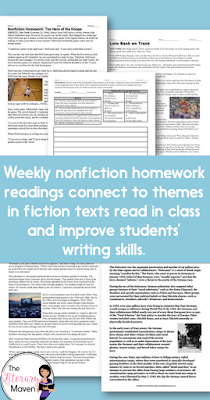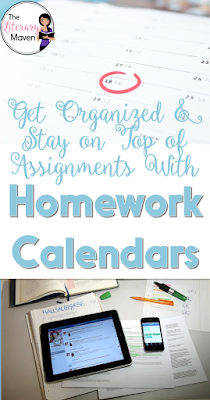Each year I have tried something different for homework for these two reasons:
1. My students, at least too many of them, don't "do" homework. It doesn't seem to matter how much or little is assigned, how easy or difficult, how "fun" or not. (I teach ninth grade English in an urban area, where for a variety of reasons homework is not a priority for many students.)
2. As a teacher given $100 for supplies each year and no paper, making copies for five classes of thirty students doesn't make me feel good when those copies get stuffed into book bags, dropped in the hallway, left behind in the classroom, etc.
Year 1 was a short and sweet approach. Students were assigned a one page (front and back) vocabulary sheet for homework. The vocabulary, usually 10 terms, connected to the week's text. On Fridays, I gave students a quick multiple-choice vocabulary quiz to help hold them accountable for doing their homework.
Year 2, I stuck with the one page vocabulary homework, but started limiting the students' time for the vocabulary quiz to five minutes. If they did their homework, they got it done, no problem. If they didn't do their homework, the whole period wouldn't be wasted on a 10 question multiple-choice quiz. because I had smaller classes (my school had a limited number of novels), I also started assigning students independent reading as part of their homework. Sometimes students had a choice of novels, sometimes I selected one for them. Students were assigned a certain number of pages a week to read and had to complete a certain number of comprehension questions. At the end of each novel, students completed a project or essay.
Year 3, I moved to a different school and went back to just the one page vocabulary homework.
Year 4, I switched schools again. Same one page vocabulary homework, but I also wanted increase the amount of nonfiction my students were reading. I created a series of one page nonfiction articles connected to the themes of the texts (primarily fiction) being read in class. On the back side of each article, students had a choice of paragraph formats to use to respond to the article. The paragraph formats helped to support my struggling writers and I also printed a lower level version of the article for my students with really low reading levels.
My initial nonfiction article set has general high-interest topics for teens. I also created set of Holocaust related readings to accompany my unit on Night, a set of hero/journey readings to accompany my unit on The Odyssey, and a set of drama/film related readings to accompany my unit on Romeo & Juliet. I loved these nonfiction homework assignments and could see an improvement in the writing of the students who completed them, but unfortunately too many students weren't doing them, which meant a whole lot of paper was getting wasted.
Year 5, I thought I had THE solution. I decided to continue with vocabulary based homework, but did a complete 180 on how I taught vocabulary. Instead of using vocabulary selected from weekly in-class texts, I decided to teach root-based vocabulary. Each week students were assigned a root and five words that shared that root.
For homework, students selected three assignments per week from a vocabulary choice board. Each week, the students would have a new root and five new words (printed on a half sheet of paper), but the homework choices remained the same, which meant waaaay less copying and wasted paper. The choice board had 30-40 choice in the categories of practice/word relationships, writing, visualization, and kinesthetic/movement. Students were not allowed to repeat choices within a month.
I also created a class website where I posted videos related in-class concepts and topics. As part of their homework, students were asked to watch and respond to the videos. This presented additional issues. Many of my students don't have computers with internet access at home and the website didn't seem to work reliably on cell phones, so I had to offer alternatives to this online homework. I also had to monitor the students' posts and remember to assign the homework. My use of the class website as part of homework was spotty at best throughout the year.
This year, year 6, my homework routine changed for different reasons. I loved my root-based vocabulary from the previous year, but my school decided to purchase a vocabulary books for all four grades, and since we were spending the money on the books, we were expected to use them. I also wanted to incorporate independent reading again.
I knew I would have to find a way to keep both myself and my students accountable. Posting the assignments in class daily or weekly would be a waste of precious class time plus I could forget to do it, students could choose not to copy it down, and it would be a nightmare to keep up with students who were frequently absent. And that is when I came up with my brilliant idea, homework calendars!
Homework calendars are exactly what they sound like, a calendar of homework assignments. I printed a homework calendar for each month, broken down by week and then by day.
Homework calendars are awesome because:
1. Students always have their assignments even if they are absent, mentally absent, come late, go to the nurse's office, etc.
2. I can't forget to assign it.
3. No time is wasted copying it down.
4. It is easy for students to catch up on assignments and even work ahead if they want.
5. It makes homework assignments clear for parents, and can easily be emailed or given out at Back to School Night or parent/teacher conferences.
6. It can be created, copied, and handed out every few weeks or monthly.
7. You can make your homework calendar as detailed as you want and then send shorter messages via text using Remind.
Creating a homework calendar requires some advance planning, but is definitely worth it!







This comment has been removed by the author.
ReplyDeleteI started using nonfiction articles in my 7th-8th classroom this year after learning more about Kelly Gallagher's Article of the Week. I'm curious about the types of paragraph formats students can choose from after they read an article. Can you explain this with a bit more detail? Thanks!
ReplyDeleteElle,
DeleteI'd be happy to email you a sample. You can reach me at brynnallison@theliterarymaven.com.
Thanks!